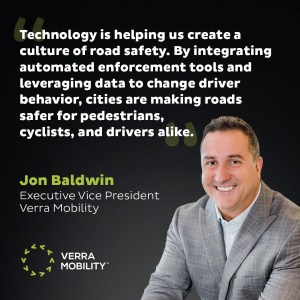
AI: Not just a buzzword
July 24, 2025
Verra Mobility honors National Stop on Red Week
July 31, 2025
Insights from Verra Mobility’s Jon Baldwin at the World Traffic Safety Symposium


At the 2025 World Traffic Safety Symposium during the New York International Auto Show, Jon Baldwin, executive vice president of Verra Mobility, joined transportation leaders for a fireside chat titled The Tech-Based Future of Urban Mobility Safety. Moderated by NYC Department of Transportation Commissioner Ydanis Rodriguez, the conversation centered around how public-private collaboration is translating today’s technology into safer roads.
For Baldwin, the discussion came down to a powerful question: How do we turn possibility into reality?
“From a pure tech perspective, it’s amazing where we are,” Baldwin shared. “If you think about sci-fi movies from 10 years ago, a lot of that tech is now real. The big question now is: how do we turn those possibilities into real-world programs?”
The answer lies in the coordinated deployment of proven tools – like automated speed enforcement – and the smart use of data to guide decision-making and shape driver behavior.
A Culture of Road Safety Starts with Behavior
“Technology is helping us create a culture of road safety,” said Baldwin. “By integrating automated enforcement tools and leveraging data to change driver behavior, cities are making roads safer for pedestrians, cyclists, and drivers alike.”
Verra Mobility plays a central role in this effort. In 2024 alone, the company processed nearly 50 million violations for illegal driving behavior – data that not only holds drivers accountable but also informs future enforcement strategies. More telling is the behavioral shift that follows: 70% of those who received a citation didn’t get a second one.
“That means we positively influenced the behavior of about 35 million people,” Baldwin said. “Automated enforcement keeps safety top of mind. If you get a speeding ticket, you’re more likely to think twice next time.”
Behind the Tech: Partnership and Implementation
While the tools might look simple – a camera on a pole – Baldwin emphasized that real-world impact depends on strong collaboration between city agencies, law enforcement, and private partners.
“Deploying these systems may look simple, but behind the scenes is complex coordination with city agencies, police, and communities,” he said. “These partnerships are crucial to making sure the technology meets the unique needs of each community.”
The fireside chat also touched on how these partnerships are helping cities advance toward ambitious safety goals like Vision Zero – the commitment to eliminate all traffic fatalities and serious injuries.
From Potential to Progress
While artificial intelligence continues to enhance how Verra Mobility monitors traffic patterns and identifies violations, it’s the application of these capabilities – not the technology itself – that’s moving the needle.
“Technology has the potential to save millions of lives by preventing crashes before they happen,” Baldwin said. “The technology is just the tip of the spear – the real impact comes from changing driver behavior.”
The World Traffic Safety Symposium offered a glimpse into the future of safer, smarter urban mobility. More importantly, it showcased how leaders like Verra Mobility are helping cities move from promise to progress – turning the tools of today into lasting change on our roads.

